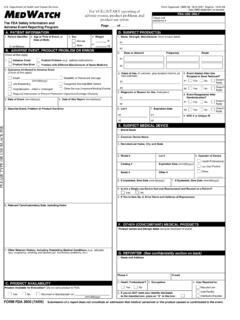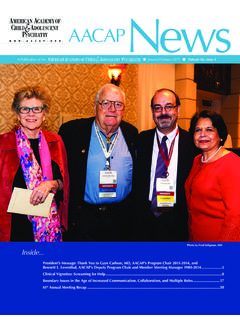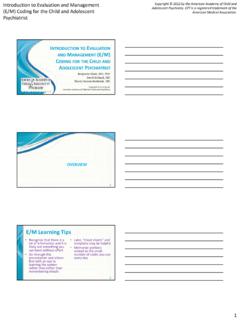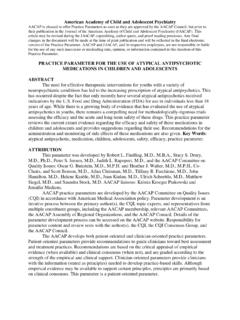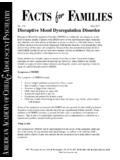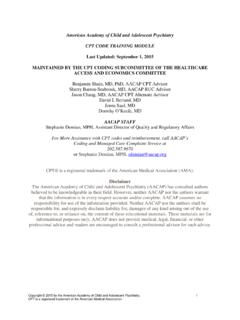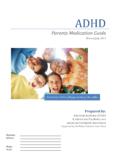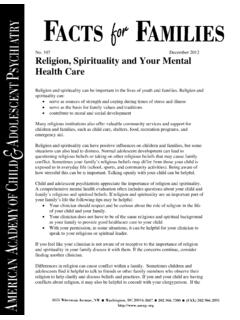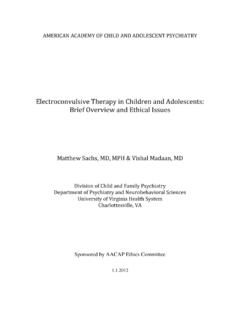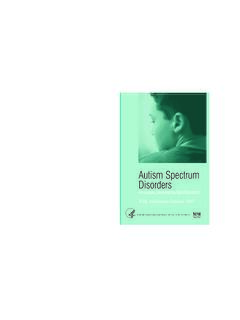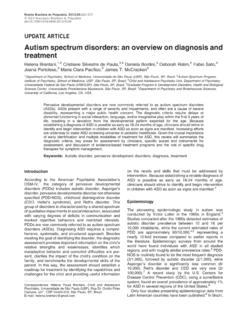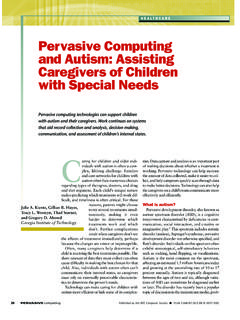Transcription of PRACTICE PARAMETER FOR THE ASSESSMENT AND …
1 American Academy of Child and Adolescent Psychiatry AACAP is pleased to offer PRACTICE parameters as soon as they are approved by the AACAP Council, but prior to their publication in the Journal of the American Academy of Child and Adolescent Psychiatry (JAACAP). This article may be revised during the JAACAP copyediting, author query, and proof reading processes. Any final changes in the document will be made at the time of print publication and will be reflected in the final electronic version of the PRACTICE PARAMETER . AACAP and JAACAP, and its respective employees, are not responsible or liable for the use of any such inaccurate or misleading data, opinion, or information contained in this iteration of this PRACTICE PARAMETER . PRACTICE PARAMETER FOR THE ASSESSMENT AND TREATMENT OF CHILDREN AND ADOLESCENTS WITH autism SPECTRUM DISORDER ABSTRACT autism spectrum disorder (ASD) is characterized by patterns of delay and deviance in the development of social, communicative, and cognitive skills which arise in the first years of life.
2 Although frequently associated with intellectual disability, this condition is distinctive in terms of its course, impact, and treatment. ASD has a wide range of syndrome expression and its management presents particular challenges for clinicians. Individuals with an ASD can present for clinical care at any point in development. The multiple developmental and behavioral problems associated with this condition necessitate multidisciplinary care, coordination of services, and advocacy for individuals and their families. Early, sustained intervention and the use of multiple treatment modalities are indicated. Key Words: autism , PRACTICE parameters , guidelines, developmental disorders , pervasive developmental disorders . ATTRIBUTION This PARAMETER was developed by Fred Volkmar, , Matthew Siegel, , Marc Woodbury-Smith, , Bryan King, , James McCracken, , Matthew State, , and the American Academy of Child and Adolescent Psychiatry (AACAP) Committee on Quality Issues (CQI): William Bernet, , Oscar G.
3 Bukstein, , and Heather J. Walter, , Co-Chairs; and Christopher Bellonci, , R. Scott Benson, , Regina Bussing, , Allan Chrisman, , Tiffany R. Farchione, , John Hamilton, , Munya Hayek, , Helene Keable, , Joan Kinlan, , Nicole Quiterio, , Carol Rockhill, , Ulrich Schoettle, , Matthew Siegel, , and Saundra Stock, , AACAP liaisons: Kristin Kroeger Ptakowski, Jennifer Medicus. AACAP PRACTICE parameters are developed by the AACAP CQI in accordance with American Medical Association policy. PARAMETER development is an iterative process between the 2 primary author(s), the CQI, topic experts, and representatives from multiple constituent groups, including the AACAP membership, relevant AACAP Committees, the AACAP Assembly of Regional Organizations, and the AACAP Council. Details of the PARAMETER development process can be accessed on the AACAP Web site. Responsibility for PARAMETER content and review rests with the author(s), the CQI, the CQI Consensus Group, and the AACAP Council.
4 The AACAP develops both patient-oriented and clinician-oriented PRACTICE parameters . Patient-oriented parameters provide recommendations to guide clinicians toward best ASSESSMENT and treatment practices . Recommendations are based on the critical appraisal of empirical evidence (when available) and clinical consensus (when not), and are graded according to the strength of the empirical and clinical support. Clinician-oriented parameters provide clinicians with the information (stated as principles) needed to develop PRACTICE -based skills. Although empirical evidence may be available to support certain principles, principles are primarily based on clinical consensus. This PARAMETER is a patient-oriented PARAMETER . The primary intended audience for the AACAP PRACTICE parameters is child and adolescent psychiatrists; however, the information contained therein may also be useful for other mental health clinicians. The authors wish to acknowledge the following experts for their contributions to this PARAMETER : Andres Martin, , Schuyler Henderson, , Rhea Paul, , Joaquin Fuentes, , Christopher McDougle, , Ami Klin, and Connie Zajicek, This PRACTICE PARAMETER was reviewed at the Member Forum at the AACAP Annual Meeting in October 2006.
5 From March to June 2012, this PARAMETER was reviewed by a Consensus Group convened by the CQI. Consensus Group members and their constituent groups were as follows: Oscar G. Bukstein, , co-chair, R. Scott Benson, , John Hamilton, (CQI); Doug Novins, , Christopher Thomas, (Topic Experts); Bryan King, (AACAP autism and Intellectual Disability Committee), Melissa DelBello, (AACAP Research Committee); John Rose, , Syed Naqvi, (AACAP Assembly of Regional Organizations); and Louis Kraus, , Tami Benton, (AACAP Council). Disclosures of potential conflicts of interest for authors and CQI chairs are provided at the end of the PARAMETER . Disclosures of potential conflicts of interest for all other individuals 3 named above are provided on the AACAP Web site on the PRACTICE parameters page. This PRACTICE PARAMETER was approved by the AACAP Council on July 8, 2013. This PRACTICE PARAMETER is available on the internet ( ). Correspondence to the AACAP Communications Department, 3615 Wisconsin Ave.
6 , NW, Washington, 20016. 2013 by the American Academy of Child and Adolescent Psychiatry. INTRODUCTION Since the first PRACTICE PARAMETER for the ASSESSMENT and Treatment of Children, Adolescents, and Adults with autism and Other pervasive Developmental Disorders1 was published, several thousand research and clinical papers have appeared and the diagnostic criteria for autism have changed. This PARAMETER revision provides the opportunity to update the previous version and incorporate new research. As the extant body of research was performed under the DSM-IV TR diagnostic schema, the evidence will be presented utilizing that terminology. This PARAMETER is applicable to evaluation of children and adolescents (age 17 and younger), but often will have some relevance to adults as well. This document presumes basic familiarity with aspects of normal child development and child psychiatric diagnosis and treatment. Unless otherwise noted, the term child refers both to adolescents and younger children, and parents refers to the child s primary caretakers regardless of whether they are the biological or adoptive parents or legal guardians.
7 METHODOLOGY The first version of this PARAMETER was published in 1999. For this revision, the literature search covered the period 1991 to March 19, 2013 using the PubMed, PsycINFO, Cochrane and CINAHL (EBSCO) databases. The initial searches were inclusive and sensitive. Search terms were a combination of MeSH headings and keywords, and the MeSH headings were adjusted to terms used by PsycINFO and CINAHL by utilizing their thesauri. In PubMed the MeSH terms Autistic Disorder, Childhood Development disorders - pervasive , Asperger*, and Rett*, as well as keyword autism were searched. The initial search yielded 20,807 results. Results were then limited to English, human, all child (0 to 18 years) 4 and 1991 to March 19, 2013. Additional limits included: classical article, clinical trial, comparative study, controlled clinical trial, evaluation studies, guideline, historical article, meta-analysis, PRACTICE guideline, multicenter study, randomized controlled trial, review, twin study and validation studies.
8 The refined PubMed search yielded 3,613 articles. In the PsycINFO database subject headings (focused) of autism , autistic thinking, pervasive developmental disorders , retts syndrome, aspergers, and keyword autism were searched. The initial search returned 24,875 articles and was then limited to English, childhood: birth to age 12yrs, adolescence: age 13-17 yrs, peer reviewed journal, and 1991 to March 19, 2013. The refined PsycINFO search yielded 9,583 articles. In the Cochrane Database of Systematic Reviews keywords of autism , autistic, rett*, asperger* or ( pervasive and disorder* and develop*) were searched without additional limits. The Cochrane search yielded 95 articles. An additional 517 articles were retrieved from the CINAHL database, after excluding Medline articles, by searching autistic disorder , autism , asperger syndrome , child development disorders , pervasive and rett syndrome . A total of 13,808 articles were identified and exported to the EndNote reference management program.
9 After removing duplicate references the resulting yield from the comprehensive search was 9,581 articles. The titles and abstracts of all articles were reviewed. Studies were selected for full text review based upon their place in the hierarchy of evidence ( randomized controlled trials), quality of individual studies, and generalizability to clinical PRACTICE . The search was augmented by review of articles nominated by expert reviewers and further search of article reference lists and relevant textbook chapters. A total of 186 articles were selected for full text examination. CLINICAL PRESENTATION AND COURSE autism was first described in 1943 by Leo Kanner2 who reported 11 children with an apparently congenital inability to relate to other people, but who were quite sensitive to change in the nonsocial environment. Kanner emphasized that the lack of interest in people was in stark contrast to the profound social interest of normal infants. He also observed that when language developed at all it was marked by echolalia, pronoun reversal, and concreteness.
10 The children also exhibited unusual, repetitive, and apparently purposeless activities (stereotypies). autism 5 was initially believed to be a form of childhood psychosis but, by the 1970s, various lines of evidence made it clear that autism was highly distinctive. By 1980, autism was officially recognized as a diagnosis in Under DSM-IV TR, the diagnosis of autism required disturbances in each of three domains: (i) social relatedness, (ii) communication/play, and (iii) restricted interests and activities with onset by age three The disturbance in social relatedness is striking and includes marked impairment in non-verbal communication, peer relationships and social-emotional reciprocity. Impairments in communication include either a delay or total lack of spoken language (without an attempt to compensate through other means) or, for verbal individuals, a marked difficulty in the ability to sustain or initiate conversation, stereotyped and repetitive (or idiosyncratic) language and lack of developmentally-appropriate make-believe or social play.
